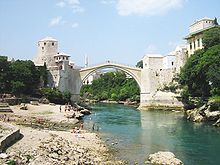Stari Most
| Stari Most | |
|---|---|
 |
|
| Carries | Pedestrians |
| Crosses | Neretva |
| Locale | Mostar, Bosnia and Herzegovina |
| Official name | Stari most |
| Characteristics | |
| Design | Arch |
| Total length | 29 metres |
| Width | 4 metres |
| Clearance below | 20 metres at mid-span |
| History | |
| Opened | 1566/1567/2004 |
| Official name | Old Bridge Area of the Old City of Mostar |
| Type | Cultural |
| Criteria | vi |
| Designated | 2005 (29th session) |
| Reference no. | 946 |
| State Party |
|
| Region | Europe and North America |
Stari Most (English: Old Bridge) is a 16th-century Ottoman bridge in the city of Mostar in Bosnia and Herzegovina that crosses the river Neretva and connects the two parts of the city. The Old Bridge stood for 427 years, until it was destroyed on 9 November 1993 by Croat forces during the Croat–Bosniak War. Subsequently, a project was set in motion to reconstruct it, and the rebuilt bridge opened on 23 July 2004.
One of the country's most recognizable landmarks, it is considered an exemplary piece of Balkan Islamic architecture. It was designed by Mimar Hayruddin, a student and apprentice of the famous architect Mimar Sinan.
The bridge spans the Neretva river in the old town of Mostar, the city to which it gave the name. The city is the fifth-largest in the country; it is the center of the Herzegovina-Neretva Canton of the Federation of Bosnia and Herzegovina, and the unofficial capital of Herzegovina. The Stari Most is hump-backed, 4 metres (13 ft 1 in) wide and 30 metres (98 ft 5 in) long, and dominates the river from a height of 24 m (78 ft 9 in). Two fortified towers protect it: the Halebija tower on the northeast and the Tara tower on the southwest, called "the bridge keepers" (natively mostari).
The arch of the bridge was made of local stone known as tenelija. The shape of the arch is the result of numerous irregularities produced by the deformation of the intrados (the inner line of the arch). The most accurate description would be that it is a circle of which the centre is depressed in relation to the string course.
Instead of foundations, the bridge has abutments of limestone linked to wing walls along the waterside cliffs. Measuring from the summer water level of 40.05 m (131 ft 5 in), abutments are erected to a height of 6.53 metres (21 ft 5 in), from which the arch springs to its high point. The start of the arch is emphasized by a molding 0.32 metres (1 ft 1 in) in height. The rise of the arch is 12.02 metres (39 ft 5 in).
...
Wikipedia
